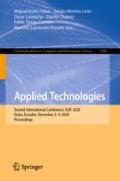Abstract
Georeferenced tools have made it possible to use the information collected through e-collaboration environments in a better way. Nevertheless, no study has been found on quantifying the influence of software tools over the capacity of interpreting data of victims of some kind of felony. This paper aims to validate the technology acceptance of applications georeferencing crimes using a prototype that could be useful for certain institutions to generate public policies. A web prototype is implemented to georeference data provided by felony acts victims. The application’s prototype was validated by a group of 122 college students using the Technology Acceptance Model. The results were interpreted with the help of Kendall Tau-b correlation analysis where highly significant positive correlation values were obtained.
Access this chapter
Tax calculation will be finalised at checkout
Purchases are for personal use only
References
DaViera, A.L., Roy, A.L., Uriostegui, M., Fiesta, D.: Safe spaces embedded in dangerous contexts: how chicago youth navigate daily life and demonstrate resilience in high-crime neighborhoods. Am. J. Community Psychol. 66, 65–80 (2020). https://doi.org/10.1002/ajcp.12434
Scassa, T.: Police service crime mapping as civic technology. Int. J. E-Planning Res. 5, 13–26 (2016). https://doi.org/10.4018/ijepr.2016070102
Vandeviver, C., Bernasco, W.: The geography of crime and crime control. Appl. Geogr. 86, 220–225 (2017 ). https://doi.org/10.1016/j.apgeog.2017.08.012
Sunehra, D., Priya, P.L., Bano, A.: Children location monitoring on google maps using GPS and GSM technologies. In: Proceedings - 6th International Advanced Computing Conference, IACC 2016, pp. 711–715 (2016). https://doi.org/https://doi.org/10.1109/IACC.2016.137.
Su Bin, O., Park, M.-H., Doo, C.: Implementation of sex crime prevention systems using the indoor location tracking system. Adv. Sci. Lett. 24(3), 1986–1990 (2018). https://doi.org/10.1166/asl.2018.11824
Galdon Clavell, G.: Exploring the ethical, organisational and technological challenges of crime mapping: a critical approach to urban safety technologies. Ethics Inf. Technol. 20, 265–277 (2018). https://doi.org/10.1007/s10676-018-9477-1
Scott, M., Delone, W., Golden, W.: Measuring eGovernment success: a public value approach. Eur. J. Inf. Syst. 25, 187–208 (2016). https://doi.org/10.1057/ejis.2015.11
Buele, J., Franklin Salazar, L., Altamirano, S., Abigail Aldás, R., Urrutia-Urrutia, P.: Platform and mobile application to provide information on public transport using a low-cost embedded device. RISTI - Rev. Iber. Sist. e Tecnol. Inf. 476–489 (2019)
Vijaya Rohini, D., Isakki, P.: Crime analysis and mapping through online newspapers: a survey. In: International Conference on Computing Technologies and Intelligent Data Engineering, ICCTIDE 2016. Institute of Electrical and Electronics Engineers Inc., pp. 1–4 (2016). https://doi.org/https://doi.org/10.1109/ICCTIDE.2016.7725331.
Salazar, F.W., Naranjo-Ávalos, H., Buele, J., Pintag, M.J., Buenaño, É.R., Reinoso, C., Urrutia-Urrutia, P., Varela-Aldás, J.: Prototype system of geolocation educational public transport through google maps API. In: Gervasi, O., Murgante, B., Misra, S., Garau, C., Blečić, I., Taniar, D., Apduhan, B.O., Rocha, A.M.A.C., Tarantino, E., Torre, C.M., Karaca, Y. (eds.) ICCSA 2020. LNCS, vol. 12254, pp. 367–382. Springer, Cham (2020). https://doi.org/10.1007/978-3-030-58817-5_28
Battin, P., Markande, S.D.: Location based reminder Android application using Google Maps API. In: International Conference on Automatic Control and Dynamic Optimization Techniques, ICACDOT 2016, pp. 649–652 (2017). https://doi.org/https://doi.org/10.1109/ICACDOT.2016.7877666
Jakkhupan, W., Klaypaksee, P.: A web-based criminal record system using mobile device: a case study of Hat Yai municipality. In: Proceedings, APWiMob 2014: IEEE Asia Pacific Conference on Wireless and Mobile 2014. Institute of Electrical and Electronics Engineers Inc., pp. 243–246 (2014). https://doi.org/https://doi.org/10.1109/APWiMob.2014.6920295
Windarni, V.A., Sediyono, E., Setiawan, A.: Using GPS and Google maps for mapping digital land certificates. In: 2016 International Conference on Informatics and Computing, ICIC 2016. pp. 422–426 (2017). https://doi.org/https://doi.org/10.1109/IAC.2016.7905756.
Tan, Q.Q., Luo, H.C., Ren, Z.L., Liu, Q.: Research on earthquake emergency response technology based on Google Maps data. In: Proceedings of 2016 2nd International Conference on Cloud Computing and Internet of Things, CCIOT 2016, pp. 85–88 (2017). https://doi.org/https://doi.org/10.1109/CCIOT.2016.7868308.
Curtis-Ham, S., Walton, D.: Mapping crime harm and priority locations in New Zealand: a comparison of spatial analysis methods. Appl. Geogr. 86, 245–254 (2017). https://doi.org/10.1016/j.apgeog.2017.06.008
Leong, L.W., Ibrahim, O., Dalvi-Esfahani, M., Shahbazi, H., Nilashi, M.: The moderating effect of experience on the intention to adopt mobile social network sites for pedagogical purposes: an extension of the technology acceptance model. Educ. Inf. Technol. 23, 2477–2498 (2018). https://doi.org/10.1007/s10639-018-9726-2
Islam, M.T., Hoque, M.R., Sorwar, G.: Understanding customers’ intention to use ecommerce in Bangladesh: an application of the technology acceptance model (TAM). In: 19th International Conference on Computer and Information Technology, ICCIT 2016. Institute of Electrical and Electronics Engineers Inc., pp. 512–516 (2017). https://doi.org/https://doi.org/10.1109/ICCITECHN.2016.7860251.
Patil, K.: Retail adoption of Internet of Things: applying TAM model. In: International Conference on Computing, Analytics and Security Trends, CAST 2016. Institute of Electrical and Electronics Engineers Inc., pp. 404–409 (2017). https://doi.org/https://doi.org/10.1109/CAST.2016.7915003.
Dele-Ajayi, O., Strachan, R., Sanderson, J., Pickard, A.: A modified TAM for predicting acceptance of digital educational games by teachers. In: IEEE Global Engineering Education Conference, EDUCON, pp. 961–968. IEEE (2017). https://doi.org/https://doi.org/10.1109/EDUCON.2017.7942965.
Davis, F.D.: Perceived usefulness, perceived ease of use, and user acceptance of information technology. MIS Q. Manag. Inf. Syst. (1989). https://doi.org/10.2307/249008
Author information
Authors and Affiliations
Corresponding author
Editor information
Editors and Affiliations
Rights and permissions
Copyright information
© 2021 Springer Nature Switzerland AG
About this paper
Cite this paper
Castillo, F., Naranjo-Ávalos, H., Buele, J., Varela-Aldás, J., Amaguaña, Y.D., Salazar, F.W. (2021). Interpreting Felony Acts Using Georeferenced Data. Case Study in Ambato, Ecuador. In: Botto-Tobar, M., Montes León, S., Camacho, O., Chávez, D., Torres-Carrión, P., Zambrano Vizuete, M. (eds) Applied Technologies. ICAT 2020. Communications in Computer and Information Science, vol 1388. Springer, Cham. https://doi.org/10.1007/978-3-030-71503-8_4
Download citation
DOI: https://doi.org/10.1007/978-3-030-71503-8_4
Published:
Publisher Name: Springer, Cham
Print ISBN: 978-3-030-71502-1
Online ISBN: 978-3-030-71503-8
eBook Packages: Computer ScienceComputer Science (R0)

